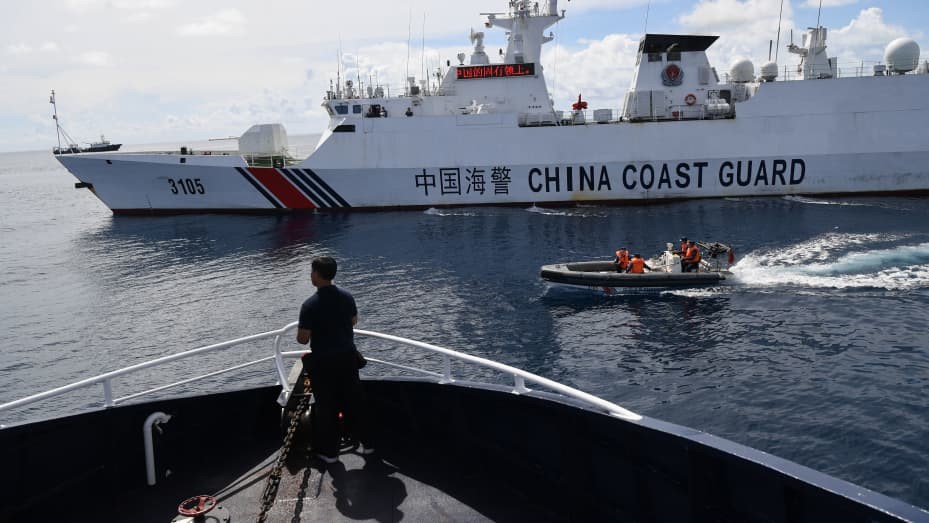The China Coast Guard is increasing its operations in the East and South China seas, along with waters close to Taiwan. This expansion involves the deployment of larger and more advanced vessels, essentially functioning as an extension of the Chinese navy. This escalation aligns with Chinese President Xi Jinping’s emphasis on Beijing’s maritime goals. Concerns have arisen among Japan, Taiwan, and the Philippines regarding the potential for inadvertent conflicts in these waters due to the heightened presence of the China Coast Guard. The apprehension stems from the belief that the increased capabilities and activities of the coast guard could lead to unintentional clashes, raising tensions in the region.
Join us on Telegram: https://t.me/tfiglobal
In a recent incident near Taiwan’s Kinmen Islands, a China Coast Guard ship instructed a nearby Taiwanese vessel to disclose its port of origin, destination, and purpose for navigating the waters via radio communication. A video released by the China Coast Guard displayed four of its vessels present at the location. The ship in question, identified as number 2202, is reportedly an updated naval missile frigate with a full-load displacement exceeding 2,000 tonnes, equipped with machine guns, according to a Hong Kong news outlet.
Ship 2202 has a history of activity in waters near the Japanese-administered Senkaku Islands, claimed by China as the Diaoyu, as highlighted in a report by a leading naval expert affiliated with the Chinese Communist Party-associated Global Times on Monday. The expert, a senior figure at the China Institutes of Contemporary International Relations, suggested that by patrolling waters near Taiwan, Ship 2202 could provide an “overwhelming advantage” over the Taiwanese side.
The Kinmen Islands, situated a short distance off the coast of Xiamen , witnessed increased tensions following a recent incident on Feb. 14, where a Chinese fishing boat capsized in Taiwanese-controlled waters, leading to two casualties. China, condemning the event, expressed disregard for Taiwan’s restrictions and announced heightened patrols by its coast guard in nearby waters. Subsequent incidents, including the boarding of a Taiwanese tourist boat and the approach of China Coast Guard vessels to Taiwan’s Matsu archipelago, have further escalated cross-strait tensions.
China has intensified its maritime presence near the Senkaku Islands in the East China Sea. Starting in January, China Coast Guard vessels have been issuing warnings to aircraft of the Japanese Self-Defense Forces, signaling them to vacate the area, as reported by a Japanese security official. Previously, the China Coast Guard insisted that Japanese coast guard and Self-Defense Forces vessels depart from Japan’s territorial waters surrounding the Senkakus. The recent development suggests a similar demand for the evacuation of traffic from Japanese airspace.
Read More: Taiwan and China Clash Over Kinmen Island Inspections
In November, Chinese President Xi Jinping visited the China Coast Guard’s command office for the East China Sea, urging heightened law enforcement measures. It is plausible that his directives have influenced the coast guard to broaden its operational scope. In 2023, Chinese government vessels were identified in the contiguous zone around the Senkakus for a record-high 352 days, marking an increase since Japan nationalized the islands in 2012. Incursions into Japanese territorial waters have also become routine, indicating a consistent trend of heightened Chinese maritime activity in the region.
In the South China Sea, recent focal points of maritime activity include the Second Thomas Shoal within the Spratly Islands. The Philippines exercises control over this shoal, where recurrent clashes between Philippine and Chinese vessels have transpired since the summer, marked by instances of the China Coast Guard deploying water cannons against Philippine vessels.
In September, the China Coast Guard implemented a 300-meter floating barrier near the Chinese-administered Scarborough Shoal, intending to obstruct vessels from the Philippines. These strategic actions coincide with the China Coast Guard’s rapid enhancement of its capabilities. Over the past decade, its fleet of vessels with a full-load displacement of 1,000 tonnes or more has almost quadrupled, reaching 157 by 2022, as reported by the Japan Coast Guard. This figure surpasses the count of comparable vessels operated by its Japanese counterpart, indicating a significant expansion in China’s maritime presence in the region.
Read More: Taiwan in Crisis: Chinese Coast Guard’s Move Sparks Panic
The China Coast Guard has reportedly acquired two patrol ships of the 10,000-tonne class, believed to be among the largest globally. Many of the recently acquired vessels showcase advanced features, including a helicopter platform, high-capacity water cannons, and 20- to 76-millimeter guns. Some are also suspected to be equipped with drones.
“China is seen to be steadily strengthening an operational posture intended to use Coast Guard vessels to intrude into Japan’s territorial waters,” the Japanese Ministry of Defense wrote in its Defense of Japan 2023 white paper.
Furthermore, the China Coast Guard has strengthened its collaboration with the military. In 2018, the agency was placed under the command of the People’s Armed Police Force, overseen by the Communist Party’s Central Military Commission. The appointment of a navy veteran as the head of the coast guard that year underscores this integration.
Legislatively, a pivotal change in 2021 designated the China Coast Guard as a quasi-military organization, granting it the authority to use force against foreign vessels perceived as infringing upon Chinese sovereignty. This legislative adjustment reflects a notable evolution in China’s approach to maritime enforcement.
